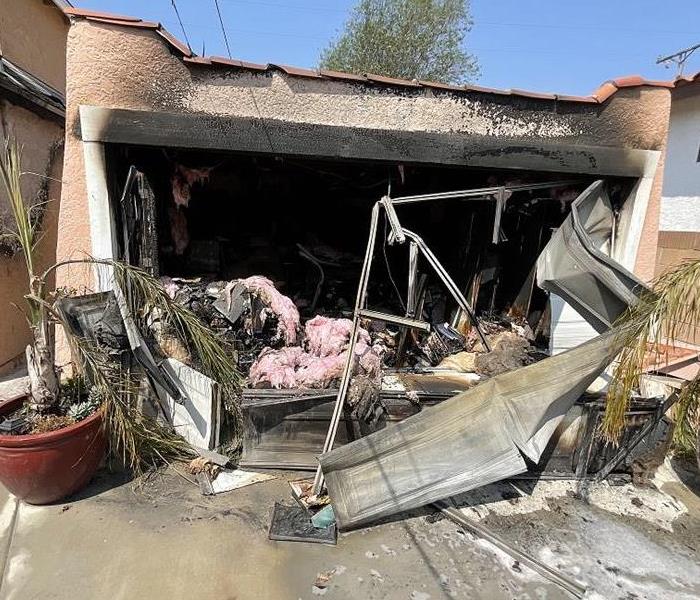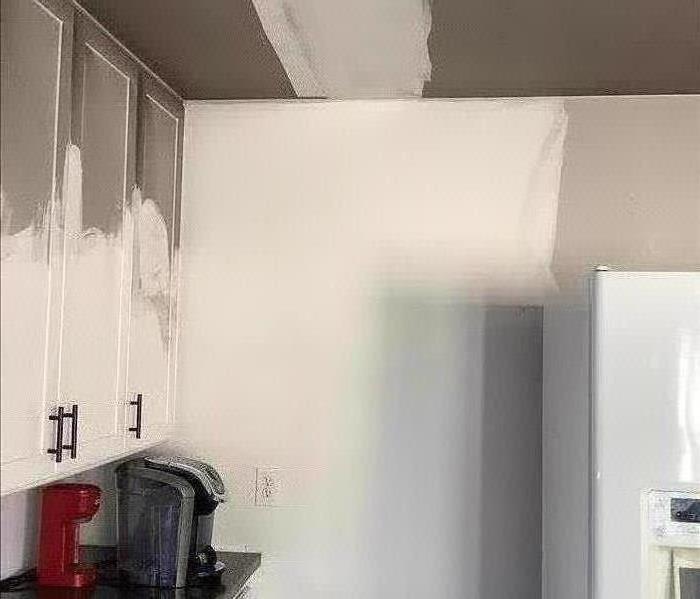Recent Fire Damage Posts
Fire safety recommendations
3/29/2023 (Permalink)
 Garage after fire department put out the fire, everything inside was lost
Garage after fire department put out the fire, everything inside was lost
Fire safety tips for every household
U.S. fire departments responded to an estimated annual average of 47,820 reported home structure fires involving electrical failure or malfunction in 2007-2011. These fires resulted in 455 civilian deaths, 1,518 civilian injuries and $1.5 billion in direct property damage.
- Replace or repair damaged or loose electrical cords.
- Avoid running extension cords across doorways or under carpets.
- In homes with small children, make sure your home has tamper-resistant (TR) receptacles.
- Consider having additional circuits or outlets added by a qualified electrician so you do not have to use extension cords.
- Follow the manufacturer's instructions for plugging an appliance into a receptacle outlet.
- Avoid overloading outlets. Plug only one high-wattage appliance into each receptacle outlet at a time.
- If outlets or switches feel warm, frequent problems with blowing fuses or tripping circuits, or flickering or dimming lights, call a qualified electrician.
- Place lamps on level surfaces, away from things that can burn and use bulbs that match the lamp's recommended wattage.
- Make sure your home has ground fault circuit interrupters (GFCIs) in the kitchen bathroom(s), laundry, basement, and outdoor areas.
- Arc-fault circuit interrupters (AFCIs) should be installed in your home to protect electrical outlets
Fire losses are very devastating to your property and dangerous as well, following these recommendations could save a life and your belongings.
Fire Safety Tips
2/5/2021 (Permalink)
U.S. fire departments responded to an estimated annual average of 47,820 reported home structure fires involving electrical failure or malfunction in 2007-2011. These fires resulted in 455 civilian deaths, 1,518 civilian injuries and $1.5 billion in direct property damage.
- Replace or repair damaged or loose electrical cords.
- Avoid running extension cords across doorways or under carpets.
- In homes with small children, make sure your home has tamper-resistant (TR) receptacles.
- Consider having additional circuits or outlets added by a qualified electrician so you do not have to use extension cords.
- Follow the manufacturer's instructions for plugging an appliance into a receptacle outlet.
- Avoid overloading outlets. Plug only one high-wattage appliance into each receptacle outlet at a time.
- If outlets or switches feel warm, frequent problems with blowing fuses or tripping circuits, or flickering or dimming lights, call a qualified electrician.
- Place lamps on level surfaces, away from things that can burn and use bulbs that match the lamp's recommended wattage.
- Make sure your home has ground fault circuit interrupters (GFCIs) in the kitchen bathroom(s), laundry, basement, and outdoor areas.
- Arc-fault circuit interrupters (AFCIs) should be installed in your home to protect electrical outlets
Wildfire Damage Event
2/4/2021 (Permalink)
The active wildfires here in Southern California are increasing their impact as growing Santa Ana winds add fuel to these devastating blazes that are encroaching in our area. According to the New York Times, new fires broke out in Malibu on December 7, with at least 96,000 acres already burned in the Ventura area and 116,000 acres in Los Angeles County. Evacuations have closed hundreds of schools and forced 200,000 of our neighbors to seek safety. The “Thomas Fire” in the Ventura area continues to burn with the aid of strong winds. This fire has caused the closure of the 101 freeway and a boil-water advisory was issued for Ventura County. Santa Ana winds The Santa Ana winds that are enabling the fires to rapidly increase their reach can have speeds in excess of 60 miles per hour. They are not expected to diminish until Friday into Saturday at the earliest. The National Weather Service has warned of “very rapid fire growth” in this area. SERVPRO Meteorologist Lela Davis said that the Santa Ana winds were already very dry when they reached the Southern California valley, allowing them to quickly pull moisture out of vegetation, increasing the risk for wildfires. For the first time ever, a purple wind warning was issued for today under the color-coded system used to advise about high winds. This purple warning pushed wind expectations from the “high” category to “extreme”. Ready to help Here at SERVPRO of Huntington Beach we are monitoring this wildfire situation closely. Our thoughts are with those neighbors who may be put in harms’ way during this event. In many cases, a wildfire can result in a total loss for a home or business, but in others it may be a partial loss, or can result in mild smoke damage. If your home or business is affected by a wildfire, SERVPRO of Huntington Beach is Here to Help®.
Huntington Beach Smoke and Soot Cleanup
9/7/2020 (Permalink)
 Smoke and soot caused by a stove in kitchen
Smoke and soot caused by a stove in kitchen
Smoke and soot are very invasive and can penetrate various cavities within your home, causing hidden damage and odor. Our smoke damage expertise and experience allows us to inspect and accurately assess the extent of the damage to develop a comprehensive plan of action.
Smoke and soot facts:
- Hot smoke migrates to cooler areas and upper levels of a structure.
- Smoke flows around plumbing systems, seeping through the holes used by pipes to go from floor to floor.
- The type of smoke may greatly affect the restoration process.
Different Types of Smoke
There are two different types of smoke–wet and dry. As a result, there are different types of soot residue after a fire. Before restoration begins, SERVPRO of Huntington Beach will test the soot to determine which type of smoke damage occurred. The cleaning procedures will then be based on the information identified during pretesting. Here is some additional information:
Wet Smoke – Plastic and Rubber
- Low heat, smoldering, pungent odor, sticky, smeary. Smoke webs are more difficult to clean.
Dry Smoke – Paper and Wood
- Fast burning, high temperatures, heat rises therefore smoke rises.
Protein Fire Residue – Produced by evaporation of material rather than from a fire
- Virtually invisible, discolors paints and varnishes, extreme pungent odor.
Our Fire Damage Restoration Services
Since each smoke and fire damage situation is a little different, each one requires a unique solution tailored for the specific conditions. We have the equipment, expertise, and experience to restore your fire and smoke damage. We will also treat your family with empathy and respect and your property with care.
Have Questions about Fire, Smoke, or Soot Damage?
Call Us Today – (714) 841-1695
Electrical Safety tips
1/7/2016 (Permalink)
 Thank you to the NFPA for these awesome tips to keep everyone safe!
Thank you to the NFPA for these awesome tips to keep everyone safe!
U.S. fire departments responded to an estimated annual average of 47,820 reported home structure fires involving electrical failure or malfunction in 2007-2011. These fires resulted in 455 civilian deaths, 1,518 civilian injuries and $1.5 billion in direct property damage.
- Replace or repair damaged or loose electrical cords.
- Avoid running extension cords across doorways or under carpets.
- In homes with small children, make sure your home has tamper-resistant (TR) receptacles.
- Consider having additional circuits or outlets added by a qualified electrician so you do not have to use extension cords.
- Follow the manufacturer's instructions for plugging an appliance into a receptacle outlet.
- Avoid overloading outlets. Plug only one high-wattage appliance into each receptacle outlet at a time.
- If outlets or switches feel warm, frequent problems with blowing fuses or tripping circuits, or flickering or dimming lights, call a qualified electrician.
- Place lamps on level surfaces, away from things that can burn and use bulbs that match the lamp's recommended wattage.
- Make sure your home has ground fault circuit interrupters (GFCIs) in the kitchen bathroom(s), laundry, basement, and outdoor areas.
- Arc-fault circuit interrupters (AFCIs) should be installed in your home to protect electrical outlets

 24/7 Emergency Service
24/7 Emergency Service
